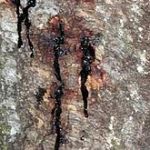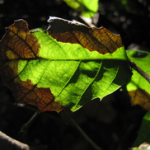Phytophthora ramorum (sudden tree death)
Sudden tree death (sometimes called sudden oak death) is the common name of a disease caused by the plant pathogen Phytophthora ramorum. The disease kills oak and other species of tree and has had devastating effects on the oak populations in California and Oregon as well as now being present in Europe. Symptoms include bleeding cankers on the tree’s trunk and dieback of the foliage, in many cases eventually leading to the death of the tree.
P. ramorum also infects a great number of other plant species, significantly woody ornamentals such as Rhododendron, Viburnum, and Pieris, causing foliar symptoms known as ramorum dieback or ramorum blight. Such plants can act as a source of inoculum for new infections, with the pathogen producing spores that can be transmitted by rainsplash and rainwater.
P. ramorum was first reported in 1995, and the origins of the pathogen are still unclear, but most evidence suggests it was repeatedly introduced as an exotic species. Very few control mechanisms exist for the disease, and at the moment authorities are relying on early detection and proper disposal of infected plant material.
There has been some cases of P. ramorum discovered on the Island, and during 2014 extensive felling amongst larch trees, which have been the worst affected, has been taking place to reduce the the transfer of the disease to other wooded areas. It is likely that all larch trees across the island will have to be felled, accounting for about 20% of the Island’s tree popuation.
It is mainly transported via water on footwear and the tyres of bycycles and motorbikes. The public are required to be extra vigilant about not proceeding into areas that have been closed off. Notices have been put up by DEFA at the entrances to affected woodlands. Please obey these notices to restrict the spread of this disease across the Island.
Please phone the Island’s Forestry dept. if you suspect that you have Phytophthora ramorum on your land (801263)

